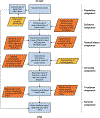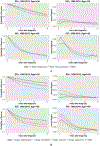A Molecular Subtype-Specific Stochastic Simulation Model of US Breast Cancer Incidence, Survival, and Mortality Trends from 1975 to 2010
- PMID: 29554473
- PMCID: PMC6538507
- DOI: 10.1177/0272989X17737508
A Molecular Subtype-Specific Stochastic Simulation Model of US Breast Cancer Incidence, Survival, and Mortality Trends from 1975 to 2010
Abstract
We present a Monte Carlo simulation model that reproduces US invasive breast cancer incidence and mortality trends from 1975 to 2010 as a function of screening and adjuvant treatment. This model was developed for multiple purposes, including to quantify the impact of screening and adjuvant therapy on past and current trends, predict future trends, and evaluate potential outcomes under hypothetical screening and treatment interventions. The model first generates the life histories of individual breast cancer patients by determining the patient's age, tumor size, estrogen receptor (ER) status, human epidermal growth factor 2 (HER2) status, SEER (Surveillance, Epidemiology, and End Results) historic stage, detection mode at time of detection, preclinical tumor course, and death age and cause of death (breast cancer v. other causes). The model incorporates common inputs used by the Cancer Intervention and Surveillance Modeling Network (CISNET), including the dissemination patterns for screening mammography, breast cancer survival in the absence of adjuvant therapy, dissemination and efficacy of treatment by ER and HER2 status, and death from causes other than breast cancer. In this article, predicted mortality outcomes are compared assuming proportional v. nonproportional hazards effects of treatment on breast cancer survival. We found that the proportional hazards treatment effects are sufficient for ER-negative disease. However, for ER-positive disease, the treatment effects appear to be higher during the early years following diagnosis and then diminish over time. Using nonproportional hazards effects for ER-positive cases, the predicted breast cancer mortality rates closely match the SEER mortality trends from 1975 to 2010, particularly after 1995. Our work indicates that population-level simulation modeling may have a broader role in assessing the time dependence of treatment effects.
Keywords: SEER; breast cancer incidence trends; breast cancer mortality trends; nonproportional hazards; time-dependent treatment effects.
Figures




Similar articles
-
Estimating Breast Cancer Survival by Molecular Subtype in the Absence of Screening and Adjuvant Treatment.Med Decis Making. 2018 Apr;38(1_suppl):32S-43S. doi: 10.1177/0272989X17743236. Med Decis Making. 2018. PMID: 29554464 Free PMC article.
-
A stochastic simulation model of U.S. breast cancer mortality trends from 1975 to 2000.J Natl Cancer Inst Monogr. 2006;(36):86-95. doi: 10.1093/jncimonographs/lgj012. J Natl Cancer Inst Monogr. 2006. PMID: 17032898
-
Association of Screening and Treatment With Breast Cancer Mortality by Molecular Subtype in US Women, 2000-2012.JAMA. 2018 Jan 9;319(2):154-164. doi: 10.1001/jama.2017.19130. JAMA. 2018. PMID: 29318276 Free PMC article.
-
Additional common inputs for analyzing impact of adjuvant therapy and mammography on U.S. mortality.J Natl Cancer Inst Monogr. 2006;(36):26-9. doi: 10.1093/jncimonographs/lgj005. J Natl Cancer Inst Monogr. 2006. PMID: 17032891 Review.
-
Trends in breast cancer incidence and mortality in the United States: implications for prevention.Breast Cancer Res Treat. 2013 Apr;138(3):665-73. doi: 10.1007/s10549-013-2500-7. Epub 2013 Apr 2. Breast Cancer Res Treat. 2013. PMID: 23546552 Review.
Cited by
-
Reflecting on 20 years of breast cancer modeling in CISNET: Recommendations for future cancer systems modeling efforts.PLoS Comput Biol. 2021 Jun 17;17(6):e1009020. doi: 10.1371/journal.pcbi.1009020. eCollection 2021 Jun. PLoS Comput Biol. 2021. PMID: 34138842 Free PMC article. Review.
-
Mathematical Modeling to Address Questions in Breast Cancer Screening: An Overview of the Breast Cancer Models of the Cancer Intervention and Surveillance Modeling Network.J Breast Imaging. 2025 Mar 18;7(2):141-154. doi: 10.1093/jbi/wbaf003. J Breast Imaging. 2025. PMID: 40036318 Review.
-
Collaborative Modeling to Compare Different Breast Cancer Screening Strategies: A Decision Analysis for the US Preventive Services Task Force.JAMA. 2024 Jun 11;331(22):1947-1960. doi: 10.1001/jama.2023.24766. JAMA. 2024. PMID: 38687505 Free PMC article.
-
Introduction to the Cancer Intervention and Surveillance Modeling Network (CISNET) Breast Cancer Models.Med Decis Making. 2018 Apr;38(1_suppl):3S-8S. doi: 10.1177/0272989X17737507. Med Decis Making. 2018. PMID: 29554472 Free PMC article.
-
Comparing CISNET Breast Cancer Incidence and Mortality Predictions to Observed Clinical Trial Results of Mammography Screening from Ages 40 to 49.Med Decis Making. 2018 Apr;38(1_suppl):140S-150S. doi: 10.1177/0272989X17718168. Med Decis Making. 2018. PMID: 29554468 Free PMC article.
References
-
- Berry DA, Cronin KA, Plevritis SK, Fryback DG, Clarke L, Zelen M, et al. Effect of screening and adjuvant therapy on mortality from breast cancer. N Engl J Med. 2005; 353(17): 1784–1792. - PubMed
-
- Piccart-Gebhart MJ, Procter M, Leyland-Jones B, Goldhirsch A, Untch M, Smith I, et al. Trastuzumab after adjuvant chemotherapy in HER2-positive breast cancer. N Engl J Med. 2005; 353(16): 1659–1672. - PubMed
-
- Romond EH, Perez EA, Bryant J, Suman VJ, Geyer CE Jr, Davidson NE, et al. Trastuzumab plus adjuvant chemotherapy for operable HER2-positive breast cancer. N Engl J Med. 2005; 353(16): 1673–1684. - PubMed
-
- Early Breast Cancer Trialists’ Collaborative Group (EBCTCG). Effects of chemotherapy and hormonal therapy for early breast cancer on recurrence and 15-year survival: an overview of the randomised trials. Lancet. 2005; 365(9472): 1687–1717. - PubMed
Publication types
MeSH terms
Substances
Grants and funding
LinkOut - more resources
Full Text Sources
Other Literature Sources
Medical
Research Materials
Miscellaneous

